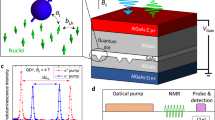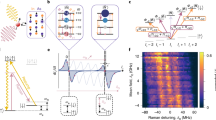Abstract
The representation of information within the spins of electrons and nuclei has been a powerful method in the ongoing development of quantum computers1,2. Although nuclear spins are advantageous as quantum bits (qubits) because of their long coherence lifetimes (exceeding seconds3), they exhibit very slow spin interactions and have weak thermal polarization. A coupled electron spin can be used to polarize the nuclear spin4,5,6 and create fast single-qubit gates7,8, however, the permanent presence of electron spins is a source of nuclear decoherence. Here we show how a transient electron spin, arising from the optically excited triplet state of C60, can be used to hyperpolarize, manipulate and measure two nearby nuclear spins. Implementing a scheme that uses the spinor nature of the electron9, we performed an entangling gate in hundreds of nanoseconds: five orders of magnitude faster than the liquid-state J coupling. This approach can be widely applied to systems comprising an electron spin coupled to multiple nuclear spins, such as nitrogen–vacancy centres in diamond10, while the successful use of a transient electron spin motivates the design of new molecules able to exploit photoexcited triplet states.
This is a preview of subscription content, access via your institution
Access options
Subscribe to this journal
Receive 12 print issues and online access
$259.00 per year
only $21.58 per issue
Buy this article
- Purchase on SpringerLink
- Instant access to full article PDF
Prices may be subject to local taxes which are calculated during checkout



Similar content being viewed by others
References
Cory, D. G., Fahmy, A. F. & Havel, T. F. Ensemble quantum computing by NMR spectroscopy. Proc. Natl Acad. Sci. USA 94, 1634–1639 (1997).
Laflamme, R., Knill, E., Zurek, W. H., Catasti, P. & Mariappan, S. V. S. NMR Greenberger–Horne–Zeilinger states. Phil. Trans. R. Soc. A 356, 1941–1948 (1998).
Morton, J. J. L. et al. Solid-state quantum memory using the 31P nuclear spin. Nature 455, 1085–1088 (2008).
Maly, T. et al. Dynamic nuclear polarization at high magnetic fields. J. Chem. Phys. 128, 052211 (2008).
Barnes, A. B. et al. High-field dynamic nuclear polarization for solid and solution biological NMR. Appl. Magn. Res. 34, 237–263 (2008).
Simmons, S. et al. Entanglement in a solid-state spin ensemble. Nature 470, 69–72 (2011).
Morton, J. J. L. et al. Bang-bang control of fullerene qubits using ultrafast phase gates. Nature Phys. 2, 40–43 (2006).
Hodges, J. S., Yang, J. C., Ramanathan, C. & Cory, D. G. Universal control of nuclear spins via anisotropic hyperfine interactions. Phys. Rev. A 78, 010303 (2008).
Schaffry, M., Lovett, B. W. & Gauger, E. M. Creating nuclear spin entanglement using an optical degree of freedom. Phys. Rev. A 84, 081305 (2011).
Robledo, L. et al. High-fidelity projective read-out of a solid-state spin quantum register. Nature 477, 574–578 (2011).
Morton, J. J. L. & Lovett, B. W. Hybrid solid-state qubits: The powerful role of electron spins. Annu. Rev. Condens. Matter Phys. 2, 1–54 (2011).
Kubo, Y. et al. Hybrid quantum circuit with a superconducting qubit coupled to a spin ensemble. Phys. Rev. Lett. 107, 220501 (2011).
Barrett, S. D. & Kok, P. Efficient high-fidelity quantum computation using matter qubits and linear optics. Phys. Rev. A 71, 060310 (2005).
Ryan, C. A., Emerson, J., Poulin, D., Negrevergne, C. & Laflamme, R. Characterization of complex quantum dynamics with a scalable NMR information processor. Phys. Rev. Lett. 95, 250502 (2005).
Vandersypen, L. M. K. et al. Experimental realization of Shor’s quantum factoring algorithm using nuclear magnetic resonance. Nature 414, 883–887 (2001).
Jones, J. A. Quantum computing with NMR. Prog. Nucl. Magn. Reson. Spectrosc. 38, 325–360 (2001).
Ryan, C. A., Moussa, O., Baugh, J. & Laflamme, R. Spin based heat engine: Demonstration of multiple rounds of algorithmic cooling. Phys. Rev. Lett. 100, 140501 (2008).
Davies, E. R. A new pulse ENDOR technique. Phys. Lett. A 47, 1–2 (1974).
Tyryshkin, A. M. et al. Coherence of spin qubits in silicon. J. Phys. 18, S783–S794 (2006).
Khaneja, N. et al. Shortest paths for efficient control of indirectly coupled qubits. Phys. Rev. A 75, 012322 (2007).
Mitrikas, G., Sanakis, Y. & Papavassiliou, G. Ultrafast control of nuclear spins using only microwave pulses: Towards switchable solid-state quantum gates. Phys. Rev. A 81, 020305 (2010).
Zhang, Y., Ryan, C., Laflamme, R. & Baugh, J. Coherent control of two nuclear spins using the anisotropic hyperfine interaction. Phys. Rev. Lett. 107, 170503 (2011).
Gauger, E. M., Rohde, P. P., Stoneham, A. M. & Lovett, B. W. Strategies for entangling remote spins with unequal coupling to an optically active mediator. New J. Phys. 10, 073027 (2008).
Isobe, H., Chen, A-J., Solin, N. & Nakamura, E. Synthesis of hydrophosphorylated fullerene under neutral conditions. Org. Lett. 7, 5633–5635 (2005).
Stoll, S. & Schweiger, A. EasySpin, a comprehensive software package for spectral simulation and analysis in EPR. J. Magn. Reson. 178, 42–55 (2006).
Emshwiller, M., Hahn, E. & Kaplan, D. Pulsed nuclear resonance spectroscopy. Phys. Rev. 118, 414–424 (1960).
Schweiger, A. & Jeschke, G. Principles of Pulse Electron Paramagnetic Resonance (Oxford Univ. Press, 2001).
Aharonov, Y. & Anandan, J. Phase change during a cyclic quantum evolution. Phys. Rev. Lett. 58, 1593–1596 (1987).
Kamata, Y., Akiyama, K., Tero-Kubota, S. & Tabata, M. Two-laser two-color time-resolved EPR study on higher, excited-state triplet-singlet intersystem crossing of porphyrins and phthalocyanines. Appl. Magn. Res. 23, 409–420 (2003).
Morello, A. et al. Single-shot readout of an electron spin in silicon. Nature 467, 687–691 (2010).
Acknowledgements
We thank B. Lovett, M. Schaffry, E. Gauger, C. Kay, A. Ardavan, A. Briggs and D. Ceresoli for helpful discussions. This work was supported by the Engineering and Physical Sciences Research Council (EPSRC) through the Centre for Advanced Electron Spin Resonance (CAESR) (EP/D048559/1) and the Materials World Network (EP/I035536/1), as well as by the European Research Council (ERC) under the European Community’s Seventh Framework Programme (FP7/2,007-2,013)/ERC grant agreement no. 279,781. We thank the Violette and Samuel Glasstone Fund, Clarendon Fund, John Templeton Foundation, St John’s College, Oxford, and the Royal Society for support.
Author information
Authors and Affiliations
Contributions
V.F., S.S. and J.J.L.M. designed and performed the experiments, analysed the results and wrote the manuscript. V.F. and F.G. performed the density functional calculations. S.D.K. and H.L.A. designed and synthesised the molecule. All authors discussed the results and manuscript.
Corresponding author
Ethics declarations
Competing interests
The authors declare no competing financial interests.
Supplementary information
Supplementary Information
Supplementary Information (PDF 4482 kb)
Rights and permissions
About this article
Cite this article
Filidou, V., Simmons, S., Karlen, S. et al. Ultrafast entangling gates between nuclear spins using photoexcited triplet states. Nature Phys 8, 596–600 (2012). https://doi.org/10.1038/nphys2353
Received:
Accepted:
Published:
Issue date:
DOI: https://doi.org/10.1038/nphys2353
This article is cited by
-
Reversible spin-optical interface in luminescent organic radicals
Nature (2023)
-
Efficient room-temperature phosphorescence of covalent organic frameworks through covalent halogen doping
Nature Chemistry (2023)
-
Triplet-mediated spin entanglement between organic radicals: integrating first principles and open-quantum-system simulations
NPG Asia Materials (2023)
-
Triplet-radical spin entanglement: potential of molecular materials for high-temperature quantum information processing
NPG Asia Materials (2022)
-
An L-band emitter with quantum memory in silicon
npj Computational Materials (2022)



